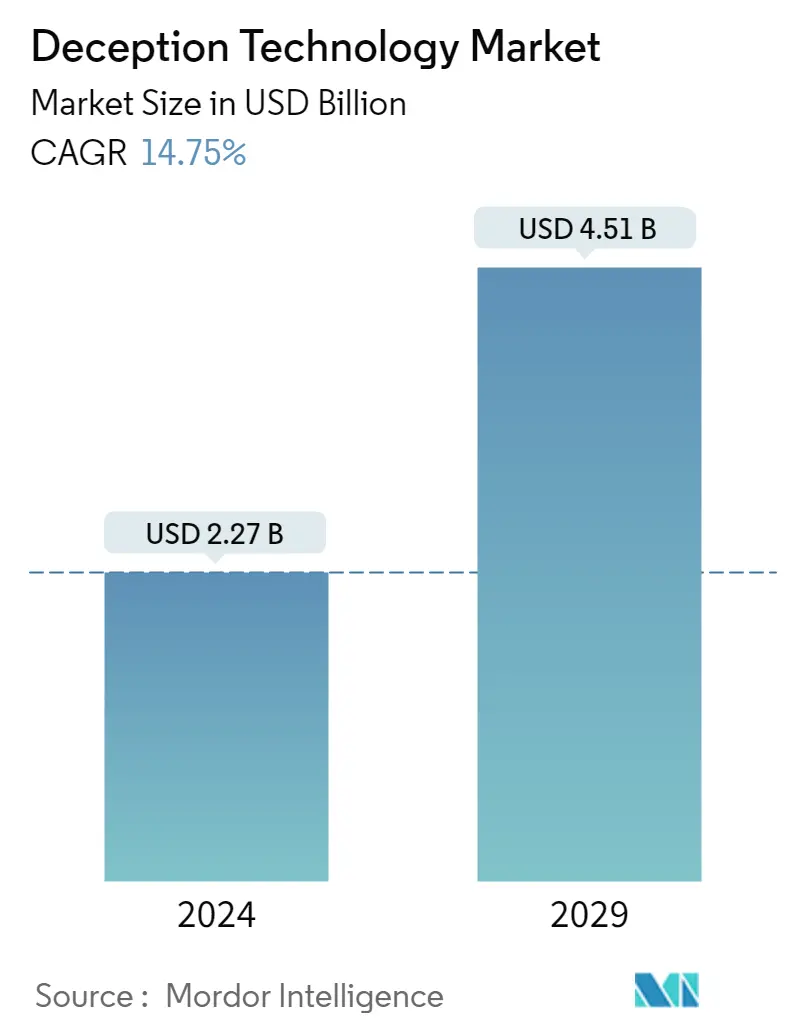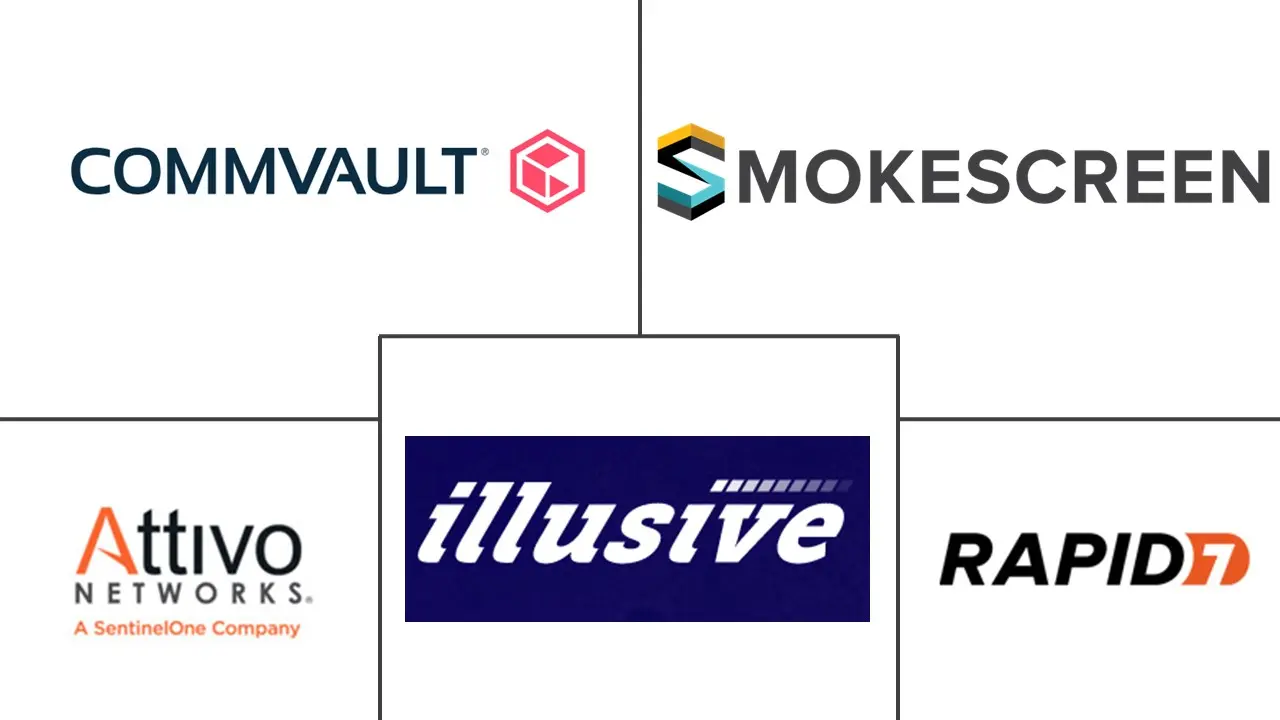Market Size of Deception Technology Industry

| Study Period | 2019 - 2029 |
| Market Size (2024) | USD 2.27 Billion |
| Market Size (2029) | USD 4.51 Billion |
| CAGR (2024 - 2029) | 14.75 % |
| Fastest Growing Market | Asia Pacific |
| Largest Market | North America |
Major Players
*Disclaimer: Major Players sorted in no particular order |
Deception Technology Market Analysis
The Deception Technology Market size is estimated at USD 2.27 billion in 2024, and is expected to reach USD 4.51 billion by 2029, growing at a CAGR of 14.75% during the forecast period (2024-2029).
- Deception technology is an advanced security solution to detect and prevent targeted attacks. Deceptions are achieved through purposeful obstructions, incorrect responses, misdirection, and forgery.
- Owing to the higher level of cyber threats, there is an increasing need for organizations to detect and mitigate advanced risks that have already breached the network. It is boosting deception technology adoption.
- The current security tools have effectively flagged anomalies but need to be more significant in defining their impact and risk potential. These tools generate many alerts, most of which must be investigated by security teams despite many of them being a waste of time. The resources are spent wastefully assessing these false threats, while the real and present threats must be addressed. By altering the asymmetry of an attack, deception technology helps security teams focus on real threats to the network. Scenes like these have aided the deception technology to gain momentum over the forecast period.
- Many deception solutions have AI and machine learning (ML) built into their core. These features ensure that deception techniques are kept dynamic and help reduce the operational overheads and the impact on security teams by freeing them from continually creating new deception campaigns.
- There was a sharp rise in cyberattacks harming individuals, businesses, and organizations during the COVID-19 outbreak. Consequently, several impacted enterprises are investing in upgrading outdated systems, thereby contributing to the deception technology market. For instance, the US Department of Homeland Security warned about emerging pandemic-related cybercriminals and advanced persistent threat groups. Interpol released a warning about criminals deliberately targeting medical facilities.
Deception Technology Industry Segmentation
The deception technology market is defined based on the revenues generated from the deception stack that is being used by various end-users across the globe. The analysis is based on the market insights captured through secondary research and the primaries. The market also covers the major factors impacting its growth in terms of drivers and restraints.
The scope of the study has been segmented based on deployment (cloud and on-premises), organization size (small and medium enterprises and large enterprises), service (managed services and professional services), deception stack (data security, application security, endpoint security, and network security), and end-user (government, medical, BFSI, defense, IT, telecommunication, and other end users) across the globe. The market sizes and forecasts are provided in terms of value in USD for all the segments.
| By Deployment | |
| Cloud | |
| On-premise |
| By Organization Size | |
| Small and Medium Enterprises | |
| Large Enterprises |
| By Service | |
| Managed Services | |
| Professional Services |
| By Deception Stack | |
| Data Security | |
| Application Security | |
| Endpoint Security | |
| Network Security |
| By End-User | |
| Government | |
| Medical | |
| BFSI | |
| Defense | |
| IT and Telecommunication | |
| Other End-Users |
| By Geography | |
| North America | |
| Europe | |
| Asia Pacific | |
| Latin America | |
| Middle East and Africa |
Deception Technology Market Size Summary
The deception technology market is poised for significant growth, driven by the increasing need for advanced security solutions to combat sophisticated cyber threats. As organizations face a rising tide of cyberattacks, including zero-day exploits and advanced persistent threats, the adoption of deception technology is becoming crucial. This technology employs tactics such as misdirection and forgery to detect and mitigate attacks, allowing security teams to focus on genuine threats rather than being overwhelmed by false alerts. The integration of artificial intelligence and machine learning into these solutions further enhances their effectiveness, reducing the operational burden on security teams. The COVID-19 pandemic has accelerated investments in upgrading cybersecurity systems, as businesses seek to protect sensitive data from emerging cybercriminals targeting critical sectors like healthcare.
North America is expected to dominate the global deception technology market, fueled by the adoption of these solutions in highly regulated industries such as finance, healthcare, and government. The region's robust infrastructure, coupled with stringent privacy laws like the California Consumer Privacy Act, drives demand for advanced security measures. The presence of major market players and the rapid adoption of technologies like 5G, AI, and IoT further contribute to market growth. The market is characterized by fragmentation, with key players engaging in strategic partnerships, innovations, and acquisitions to enhance their offerings. Notable developments include Rapid7's partnership with the University of South Florida to create a cyber threat intelligence laboratory and Commvault's launch of Metallic ThreatWise, an early warning system for zero-day threats.
Deception Technology Market Size - Table of Contents
-
1. MARKET INSIGHTS
-
1.1 Market Overview
-
1.2 Industry Attractiveness - Porter's Five Forces Analysis
-
1.2.1 Bargaining Power of Suppliers
-
1.2.2 Bargaining Power of Buyers
-
1.2.3 Threat of New Entrants
-
1.2.4 Threat of Substitutes
-
1.2.5 Intensity of Competitive Rivalry
-
-
1.3 Industry Value Chain Analysis
-
1.4 Impact of COVID-19 on the Market
-
-
2. MARKET SEGMENTATION
-
2.1 By Deployment
-
2.1.1 Cloud
-
2.1.2 On-premise
-
-
2.2 By Organization Size
-
2.2.1 Small and Medium Enterprises
-
2.2.2 Large Enterprises
-
-
2.3 By Service
-
2.3.1 Managed Services
-
2.3.2 Professional Services
-
-
2.4 By Deception Stack
-
2.4.1 Data Security
-
2.4.2 Application Security
-
2.4.3 Endpoint Security
-
2.4.4 Network Security
-
-
2.5 By End-User
-
2.5.1 Government
-
2.5.2 Medical
-
2.5.3 BFSI
-
2.5.4 Defense
-
2.5.5 IT and Telecommunication
-
2.5.6 Other End-Users
-
-
2.6 By Geography
-
2.6.1 North America
-
2.6.2 Europe
-
2.6.3 Asia Pacific
-
2.6.4 Latin America
-
2.6.5 Middle East and Africa
-
-
Deception Technology Market Size FAQs
How big is the Deception Technology Market?
The Deception Technology Market size is expected to reach USD 2.27 billion in 2024 and grow at a CAGR of 14.75% to reach USD 4.51 billion by 2029.
What is the current Deception Technology Market size?
In 2024, the Deception Technology Market size is expected to reach USD 2.27 billion.

